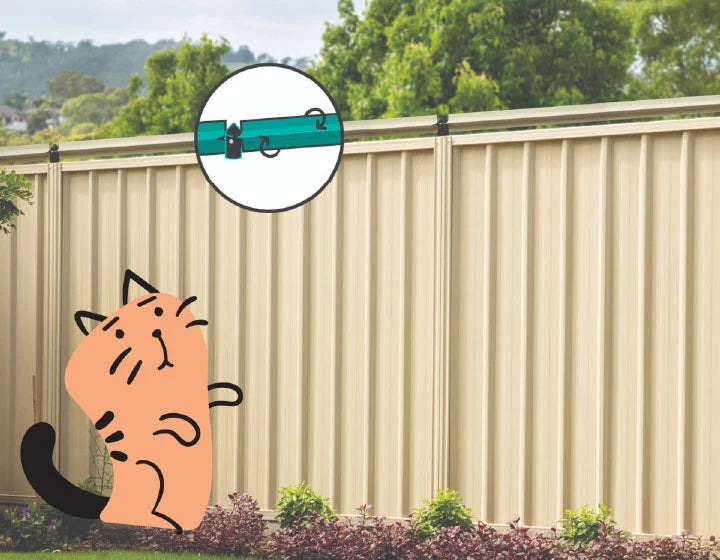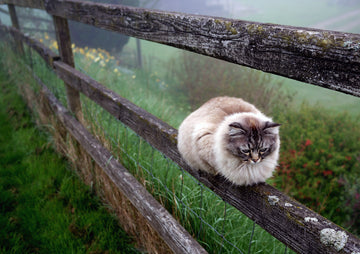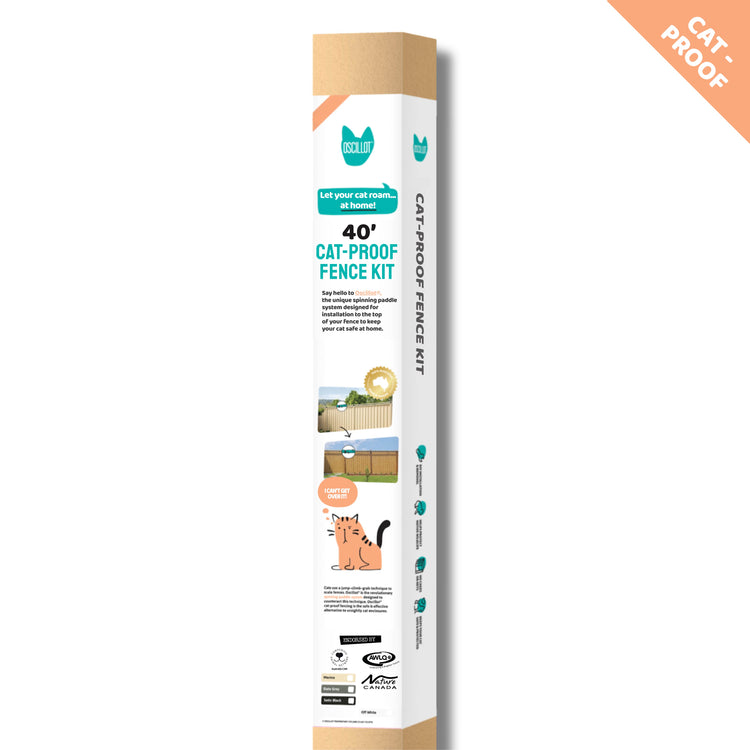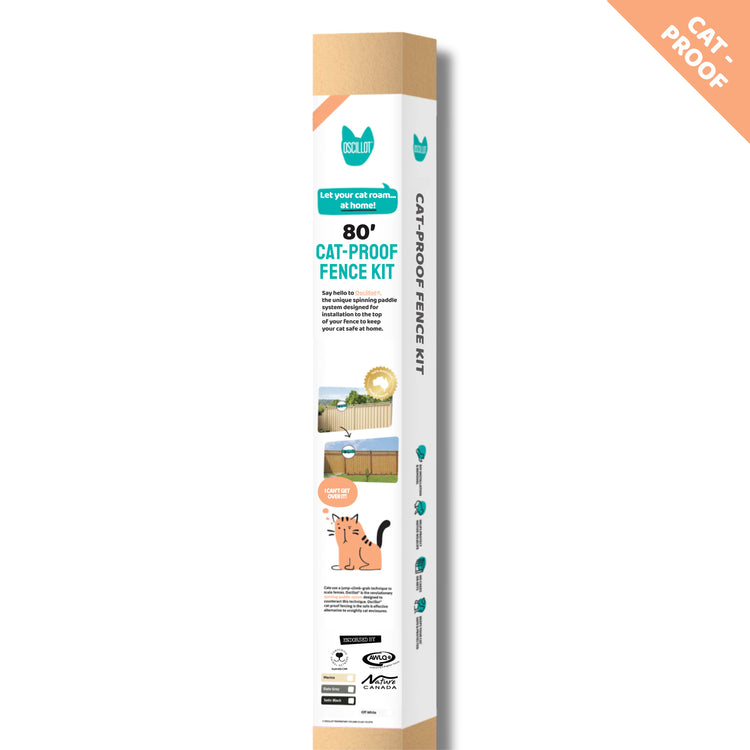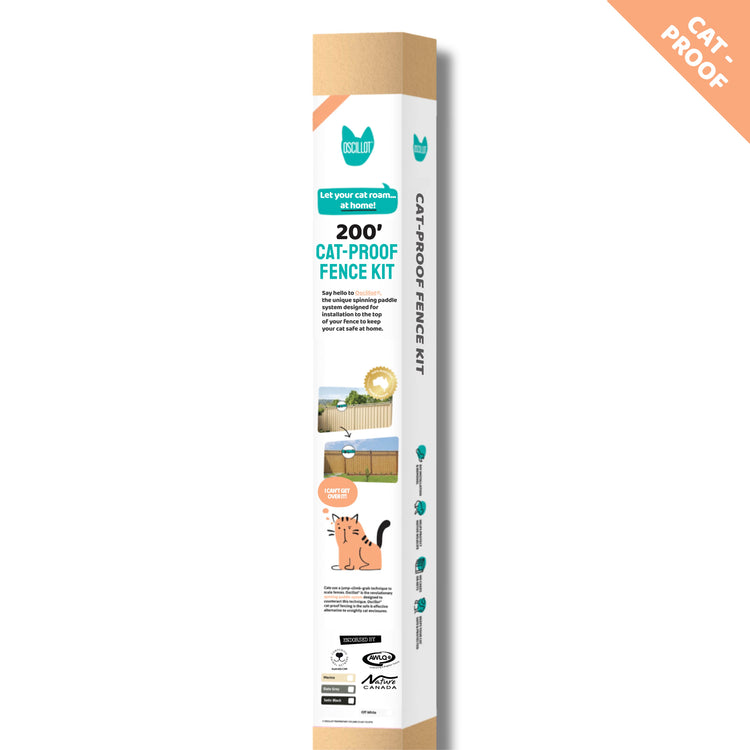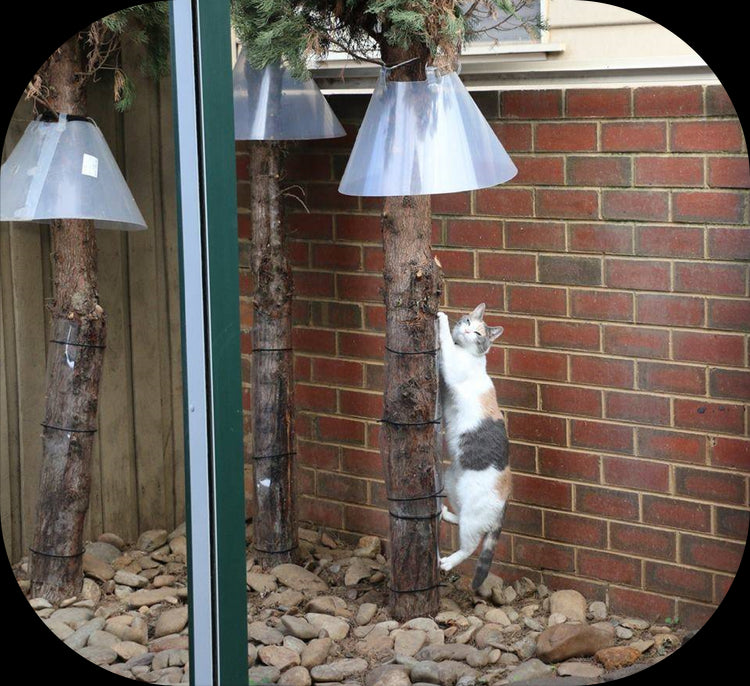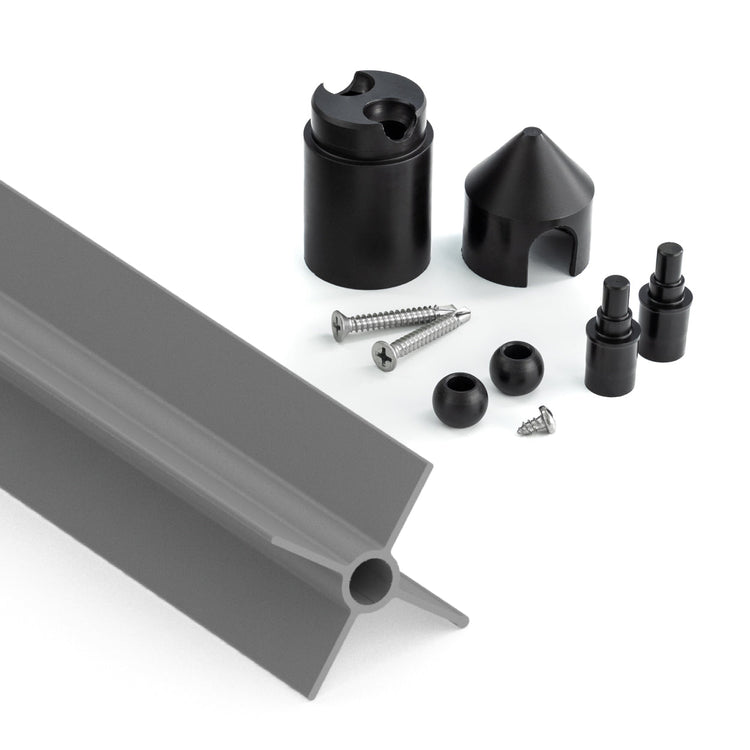Designing Calming Outdoor Areas for Cats with Fearful Tendencies

- Creating safe outdoor spaces can significantly reduce anxiety in fearful cats
- Cat-proof fencing systems like Oscillot prevent escapes while allowing natural exploration
- Proper outdoor enclosure design should include hiding spots, vertical spaces, and calming elements
- Environmental enrichment reduces stress and encourages natural behaviors
- The right containment solution can double the amount of time cats spend safely enjoying outdoors
Key Takeaways
- Fearful cats require gradual introduction to outdoor spaces over weeks or months
- Multiple escape routes and hiding places are essential for building confidence
- Vertical spaces allow cats to observe their surroundings from positions of safety
- Seasonal adaptations ensure year-round comfort and continued use
- Proper containment systems like Oscillot provide security without creating visual barriers
- Multi-cat households need carefully zoned areas to prevent territorial conflicts
- Regular monitoring and adjustments based on your cat's behavior optimize the experience
- Cat-safe plants and sensory elements can create additional calming effects
Introduction to Creating Safe Outdoor Spaces for Fearful Cats
For cats with fearful tendencies, the outdoors can represent both an exciting opportunity and a source of significant anxiety. Creating a calming outdoor environment specifically designed for these sensitive felines can dramatically improve their quality of life while ensuring their safety. While many cat owners in the USA keep their pets exclusively indoors due to safety concerns, providing controlled outdoor access through properly designed spaces offers numerous benefits for a cat's physical and mental wellbeing. Research indicates that cats who receive appropriate outdoor stimulation show improved mood, reduced stress-related behaviors, and better overall health outcomes compared to those kept exclusively indoors.
Fearful cats in particular can benefit from thoughtfully designed outdoor spaces that provide security while allowing them to engage in natural behaviors like climbing, exploring, and observing their surroundings. Research shows that cats with controlled outdoor access experience improvements across multiple welfare dimensions, including reduced fearfulness and increased positive behaviors. The key is creating an environment that balances safety with enrichment, giving these sensitive cats the confidence to explore without triggering their anxiety. Veterinary behaviorists have documented that even cats with severe anxiety can gradually become more confident through controlled exposure to enriched outdoor environments, provided these spaces are properly designed with their specific needs in mind.
In this guide, we'll explore the essential elements of designing calming outdoor areas specifically for cats with fearful tendencies. From choosing the right cat-proof fence system to incorporating soothing elements and creating strategic hiding spots, you'll learn how to transform your outdoor space into a sanctuary that helps your anxious cat thrive. Whether you have a small urban balcony or a large suburban yard, these principles can be adapted to create an outdoor environment that addresses your fearful cat's specific needs while providing the enrichment necessary for optimal feline wellbeing.
Understanding the Needs of Fearful Cats
Cats with fearful tendencies require special consideration when designing outdoor spaces. These cats may have experienced trauma, lacked proper socialization as kittens, or simply have naturally cautious personalities. Understanding their specific needs is the first step in creating an environment where they can feel secure enough to enjoy the benefits of outdoor access. Feline behavior experts emphasize that fearful cats often experience their environment differently than confident cats, with heightened sensitivity to potential threats and a stronger need for control over their surroundings.
Fearful cats typically display behaviors such as hiding, freezing, attempting to escape, excessive vocalization, or aggression when frightened. They may be startled by sudden movements, loud noises, unfamiliar people or animals, or changes in their environment. When designing an outdoor space for these cats, it's crucial to minimize these triggers while providing plenty of escape routes and safe havens. Certified animal behaviorists note that fearful cats often show subtle signs of stress before more obvious behaviors appear – these can include dilated pupils, flattened ears, tense body posture, and excessive grooming or over-grooming in specific areas.
Research has shown that cats with outdoor access experience significant improvements in their overall wellbeing, but this must be balanced with safety considerations. According to a study published in the Journal of Veterinary Behavior, installation of proper containment systems leads to cats spending significantly more time outside safely - typically doubling or more. For fearful cats, this controlled exposure to the outdoors can help reduce anxiety over time, especially when the space is designed with their specific needs in mind. Additional research from the University of Edinburgh found that cats with access to enriched outdoor environments showed measurable decreases in stress hormones compared to those kept exclusively indoors, with particularly significant improvements noted in cats with previously identified anxiety behaviors.
The key is to create an environment that allows the cat to feel in control. This means providing multiple entry and exit points, elevated perches for observation, and plenty of hiding spots where they can retreat if they feel threatened. By understanding these fundamental needs, you can design an outdoor space that helps your fearful cat build confidence while enjoying the enrichment that outdoor access provides. Feline behavior specialists recommend creating environments with "choice architecture" – designing spaces that naturally guide cats toward positive experiences while always maintaining their sense of control and ability to retreat when needed.
Essential Elements of a Calming Outdoor Space
Creating a truly calming outdoor environment for fearful cats requires careful attention to several key elements. These components work together to create a space that feels secure while providing enrichment and encouraging natural behaviors. Feline behavior specialists emphasize that the most effective outdoor spaces incorporate multiple features that address different aspects of feline security needs simultaneously.
Secure Boundaries
The foundation of any safe outdoor space for cats is a secure boundary system. For fearful cats, the security of knowing they cannot accidentally escape is particularly important. Cat-proof fence systems like Oscillot are ideal because they prevent cats from climbing over existing fences without creating a visually intimidating barrier. These systems typically consist of rotating paddles that attach to the top of your fence, making it impossible for cats to gain the grip needed to climb over. Research from the University of California's School of Veterinary Medicine indicates that the most effective containment systems are those that prevent escape without creating a sense of confinement, as visible barriers can sometimes increase anxiety in cats with fearful tendencies.
Multiple Hiding Spots
Fearful cats need plenty of places to hide when they feel threatened. Incorporate various hiding spots throughout the space, such as small shelters or houses with multiple exit points for easy escape, dense shrubs and plants that provide visual screening while allowing the cat to monitor surroundings, hollow logs or tunnels that mimic natural hiding places cats would seek in the wild, covered boxes or containers positioned at different heights throughout the space, and rock formations with small openings that create cave-like retreats. These hiding spots should be distributed throughout the area, allowing the cat to always have a safe retreat nearby no matter where they are in the space. Feline behavior experts recommend placing hiding options no more than 10-15 feet apart to ensure a fearful cat never feels trapped in an exposed area without quick access to safety.
Vertical Space
Cats naturally feel safer when they can observe their surroundings from an elevated position. Include plenty of vertical elements such as climbing trees or cat trees secured to the ground with weather-resistant materials, shelves mounted to fences or walls at varying heights to create "stepping stone" pathways, sturdy branches or logs arranged as climbing structures that mimic natural environments, and ramps and platforms at various heights to accommodate cats of different abilities and confidence levels. These elevated spaces allow fearful cats to survey their territory while feeling protected from potential threats below. Research published in the Journal of Feline Medicine and Surgery confirms that access to elevated spaces significantly reduces stress behaviors in cats, with anxious cats showing particular preference for high vantage points when available.
Calming Elements
Incorporate features that naturally reduce anxiety, including moving water features like small fountains (the gentle sound can be soothing and mask startling noises), cat-safe plants with calming scents such as catnip, silver vine, or cat thyme strategically placed near resting areas, soft, comfortable resting areas in both sun and shade with materials that maintain comfort in varying weather, and windchimes or other gentle, predictable sounds that can help mask startling noises from the neighborhood. By thoughtfully including these essential elements, you create an outdoor environment that addresses the specific needs of fearful cats, helping them feel secure enough to explore and enjoy the benefits of outdoor access. Veterinary behaviorists note that the most successful outdoor spaces incorporate elements that work together synergistically – for example, positioning hiding spots near vertical spaces so cats can quickly transition between observation and concealment as needed.
Choosing the Right Containment System
Selecting an appropriate containment system is perhaps the most critical decision when creating a safe outdoor space for fearful cats. The ideal system should prevent escapes while avoiding creating additional stress or anxiety for sensitive felines. Feline safety experts emphasize that the containment system forms the foundation of the entire outdoor experience – if cats don't feel secure within the boundaries, they won't be able to relax and enjoy the space regardless of other amenities provided.
Cat-Proof Fence Systems
Cat-proof fence systems like Oscillot offer several advantages for fearful cats. Non-intimidating appearance: Unlike full enclosures with visible mesh or netting, these systems modify existing fences with minimal visual impact, making them less likely to trigger anxiety in fearful cats. Research on feline stress responses indicates that cats can become anxious when they perceive visible barriers, making low-profile containment solutions preferable for sensitive individuals. Preservation of views: Cats can still see beyond the boundary, which can be less stressful than feeling completely confined. Behavioral studies show that maintaining visual access to the broader environment helps reduce territorial anxiety in cats while still keeping them physically contained. Adaptability: These systems can be installed on most existing fence types, allowing you to work with your current yard setup. This adaptability means you can create containment that works with your specific landscape features rather than requiring complete reconstruction of outdoor spaces. Effectiveness: The rotating paddle design physically prevents cats from gaining the grip needed to climb over fences, providing reliable containment without the need for complete enclosure. Independent testing has shown these systems to be 98% effective at preventing escapes when properly installed and maintained. When selecting a cat-proof fence system, consider the size of your yard and the existing fence. The Oscillot 120 Cat Proof Fence Kit provides 120 feet of coverage, making it suitable for medium to large yards, while smaller options like the 60" Cat Proof Fence Kit are perfect for more compact spaces. Feline safety experts recommend measuring your perimeter carefully and adding 5-10% additional material to ensure complete coverage of all potential escape points.
Fully Enclosed Catios
For extremely fearful cats or in situations where a fence modification isn't possible, a fully enclosed catio may be the best option. These structures typically consist of a rigid frame made of wood, metal, or PVC designed to withstand local weather conditions, mesh or wire walls and ceiling with openings small enough to prevent escape (typically 2"x2" or smaller), a solid roof for weather protection from rain, snow, and excessive sun exposure, and multiple levels and platforms inside to create vertical space and observation points. While catios provide maximum security, they can sometimes feel more confining to cats. If using this option for fearful cats, be sure to make the space as large as possible and include plenty of enrichment features. Veterinary behaviorists recommend a minimum of 36 square feet of floor space per cat, with additional vertical space to increase the functional size of the enclosure.
Hybrid Solutions
Some cat owners find that a combination approach works best. A cat-proof fence system around the perimeter of the yard for maximum exploration space, a smaller, fully enclosed catio attached to the house as a transitional space for building confidence, and cat-safe plants and structures throughout the yard strategically positioned to create secure pathways. This approach gives fearful cats the option to venture into the larger yard when they feel confident, while still having the security of a more contained space when needed. Feline behavior specialists often recommend this progressive approach for particularly anxious cats, as it allows them to gradually expand their comfort zone at their own pace. Whichever containment system you choose, ensure it's properly installed and regularly maintained to prevent any potential escape routes. For fearful cats, the consistency of knowing their boundaries is an important part of building confidence in the outdoor space. Experts recommend weekly inspections of all containment components to identify and address any potential weaknesses before they become escape opportunities.
Creating Strategic Hiding Spots and Escape Routes
For cats with fearful tendencies, the ability to quickly hide or escape perceived threats is essential for them to feel comfortable in an outdoor space. Strategic placement of hiding spots and escape routes throughout your outdoor area can dramatically increase a fearful cat's confidence and willingness to explore. Feline behavior specialists emphasize that the perception of safety is often more important than actual safety for anxious cats – they need to feel they can escape at any moment, even if no real threats exist in the controlled environment.
Effective Hiding Spots
When designing hiding spots for fearful cats, consider these key principles. Multiple entrances and exits: Cats feel more secure when they have more than one way to enter or leave a hiding spot. This prevents them from feeling trapped if a threat appears near one of the openings. Research on feline stress responses shows that hiding places with at least two exit points are used significantly more frequently than those with single exits, particularly by anxious cats. Strategic distribution: Place hiding spots throughout the entire outdoor area, ensuring that a cat never has to travel more than a few feet to reach safety. This creates a network of safe zones that allows fearful cats to gradually expand their territory. Feline behavior experts recommend placing hiding options approximately 8-10 feet apart to ensure cats always have quick access to safety. Varied sizes and types: Include a mix of different hiding options: small, enclosed spaces for maximum security during high-stress situations, partially covered areas for moderate protection while maintaining visibility, dense vegetation for natural concealment that mimics hiding spots cats would seek in the wild, and elevated hiding spots for cats who feel safer up high where they can observe potential threats. Weather protection: Ensure some hiding spots offer protection from rain, wind, and extreme temperatures, allowing cats to remain comfortable outdoors in various weather conditions. Weatherproof hiding options should be available in all sections of the outdoor space to prevent cats from having to choose between comfort and security.
Natural Hiding Features
Incorporate these natural elements to create hiding opportunities. Dense shrubs: Plants like boxwood, juniper, or ornamental grasses create excellent natural hiding spots that also provide sensory enrichment through scent and texture. Rock formations: Arrange rocks to create small caves or protected areas that offer both concealment and thermal regulation (cool in summer, warm in winter). Hollow logs: These provide natural tunnels and hiding places that appeal to a cat's instinct to seek shelter in enclosed spaces. Tall grasses: Areas of unmowed grass create instant hiding spots for cats to duck into when they feel threatened by overhead movements or sounds.
Constructed Hiding Options
In addition to natural elements, consider adding cat houses or shelters: small wooden structures with multiple openings positioned at different heights and orientations for maximum escape options, tunnels: PVC pipes or flexible tunnels connecting different areas to create protected travel corridors between key resources, platforms with curtains: elevated spaces with fabric hanging down to create protected areas that allow cats to remain hidden while still observing their surroundings, and repurposed containers: waterproof storage bins or barrels with openings cut into them, weatherproofed and positioned strategically throughout the space.
Creating Effective Escape Routes
Beyond hiding spots, fearful cats need clear pathways to quickly move from one area to another. Elevated pathways: Create "highways" using boards, shelves, or bridges that allow cats to travel above ground level, where they typically feel safer. Research on feline spatial preferences shows that anxious cats use elevated pathways up to three times more frequently than ground routes when both options are available. Tunnel systems: Connect different areas of the yard with tunnels made from PVC pipe, flexible dryer vent tubing, or commercial cat tunnels. These create protected travel corridors that allow cats to move between resources without feeling exposed. Clear sight lines: Ensure cats can see potential escape routes from anywhere in the space, avoiding blind corners or dead ends that might increase anxiety. Feline vision specialists note that cats need to be able to visually identify escape paths from at least 15-20 feet away to maintain confidence in new environments. Access to indoor spaces: If possible, provide cat doors or windows that allow direct access to the house, giving fearful cats the ultimate escape option when needed. Studies on feline stress behaviors indicate that simply knowing indoor access is available significantly reduces anxiety, even if cats choose to remain outdoors. By thoughtfully designing these hiding spots and escape routes, you create an environment where fearful cats can gradually build confidence. The knowledge that safety is always within reach allows these sensitive cats to explore more freely, ultimately helping them overcome their fears while enjoying the benefits of outdoor access. Feline behavior experts emphasize that this network of safety features creates a psychological foundation that allows anxious cats to develop new, positive associations with outdoor environments over time.
Incorporating Calming Elements and Enrichment
Creating a truly therapeutic outdoor environment for fearful cats goes beyond just safety measures. Incorporating specific calming elements and enrichment opportunities can significantly reduce anxiety while encouraging natural behaviors that contribute to overall wellbeing. Research in feline environmental psychology shows that thoughtfully designed sensory elements can actually help rewire a fearful cat's brain over time, creating new positive associations with outdoor experiences.
Calming Sensory Elements
Engage all of your cat's senses with elements specifically chosen to reduce anxiety. Visual Calming: Use natural screens like tall grasses or plants to block potentially stressful views such as busy streets or neighboring yards with dogs, incorporate moving elements like butterfly gardens or bird feeders (placed outside the cat's reach) for gentle visual stimulation that engages natural hunting instincts without frustration, choose muted, natural colors for structures rather than bright, potentially startling colors that might increase visual stress, and create dappled light patterns through pergolas or shade cloths that mimic the forest canopy environments where cats naturally feel secure. Auditory Considerations: Create gentle background sounds with small water features that produce consistent, predictable sounds to mask sudden noises, use wind chimes with soft tones to mask sudden noises from the neighborhood while creating auditory landmarks, position the space away from loud street noise or neighbor activity when possible, using sound-absorbing features like dense shrubs as buffers, and consider outdoor-safe white noise machines in areas where outside noise cannot be controlled, particularly near resting spots. Olfactory Elements: Plant cat-safe herbs with calming properties like valerian, catnip, or silver vine in protected corners to create positive associations with the space, create designated areas for rolling and scent marking to help cats establish territorial security through familiar scents, consider using synthetic feline pheromones in key areas to promote feelings of security, particularly near entry points and new features, and include a variety of cat-safe plants with different scents to create a rich sensory landscape that encourages exploration. Tactile Comfort: Provide various surfaces for cats to explore – smooth stones, soft grass, rough bark – creating a diverse tactile environment, include comfortable resting spots with different textures (outdoor-safe bedding, carpet scraps, etc.) positioned in both sun and shade, create sunny spots for warmth and shaded areas for cooling to accommodate temperature preferences that may change throughout the day, and incorporate different substrate materials in various zones to create distinct tactile territories.
Environmental Enrichment
Enrichment activities are crucial for fearful cats, as positive experiences help build confidence. Hunting Opportunities: Hide treats or puzzle feeders throughout the space to encourage exploration and reward brave behavior, install butterfly or bird feeders outside the enclosure for visual hunting stimulation without allowing actual predation, use motion-activated toys that mimic prey movement, strategically placed in areas where the cat is beginning to show comfort, and create insect-friendly plantings that attract natural prey-like movement for cats to observe. Climbing and Perching: Create a variety of levels using cat-safe tree guards, shelves, and platforms at different heights to accommodate varying confidence levels, install sturdy branches or logs for natural climbing that provides both exercise and cognitive stimulation, position perches near the fence line for observation opportunities that satisfy territorial monitoring instincts, and include platforms of different sizes and stability levels to provide physical challenges as confidence grows. Exploration Features: Create winding paths through vegetation that encourage movement while maintaining a sense of protection, use different ground textures in various areas to stimulate paw sensory receptors and encourage full-body awareness, incorporate tunnels and passages between different sections to create an environment that rewards curiosity, and add seasonal elements that change the environment subtly over time, maintaining interest without creating stress. Interactive Elements: Install weather-resistant scratching posts or surfaces in multiple locations to satisfy natural marking behaviors, create digging areas with loose soil or sand that allow for natural digging behaviors in appropriate locations, add rolling toys that can withstand outdoor conditions, secured to prevent loss and positioned in areas the cat already feels comfortable, and include self-play options that don't require human interaction for times when the cat wants to engage independently.
Seasonal Considerations
Adapt your outdoor space to remain calming throughout the year. Summer Adaptations: Ensure abundant shade options that move with the sun's position throughout the day, provide fresh water sources in multiple locations, including moving water features that encourage hydration, create cooling stations with damp towels or shallow water dishes for paw dipping during extreme heat, and position key resources to avoid hot surfaces and direct sun during peak temperature hours. Winter Preparations: Install heated shelters or beds that maintain a comfortable temperature even in cold weather, position structures to maximize sun exposure during winter months when warmth is beneficial, create windbreaks around favorite resting areas to block cold breezes while maintaining visibility, and ensure pathways remain clear of snow and ice to prevent mobility challenges that might increase anxiety. Rain and Weather Protection: Include waterproof shelters strategically positioned throughout the space, not just near the house, create covered pathways between key areas to allow movement during inclement weather without exposure, ensure proper drainage to prevent puddles and mud that might deter cats from using important areas, and install weather-resistant materials that maintain their integrity and familiar scent despite exposure. By thoughtfully incorporating these calming elements and enrichment opportunities, you create an outdoor environment that not only feels safe for fearful cats but actively helps reduce their anxiety while encouraging natural behaviors. This holistic approach addresses both the physical and psychological needs of sensitive felines, helping them gradually build confidence in their outdoor adventures. Feline behaviorists note that the most successful outdoor spaces evolve over time, with owners adding and adjusting elements based on their specific cat's responses and developing preferences.
Managing Multi-Cat Dynamics in Outdoor Spaces
Creating a calming outdoor environment becomes more complex when multiple cats are involved, especially when one or more have fearful tendencies. Careful planning is essential to ensure that all cats can enjoy the space without creating additional stress for more sensitive individuals. Feline behavior specialists emphasize that outdoor dynamics between cats often differ significantly from indoor relationships, requiring thoughtful design to accommodate these differences.
Understanding Cat Social Dynamics
Before designing a multi-cat outdoor space, consider these important factors. Existing relationships: Cats who already get along indoors are more likely to share outdoor space harmoniously. Those with tense relationships will need more careful management. Research on feline social structures indicates that outdoor territories often amplify existing relationship dynamics rather than changing them fundamentally. Individual personalities: Some cats are naturally more territorial outdoors than indoors, which can change established dynamics. Studies of feral cat colonies show that outdoor spaces typically require 2-3 times more territory per cat than indoor environments to maintain peaceful coexistence. Resource competition: Even friendly cats may compete for prime outdoor spots, which can create tension. Behavioral research shows that resource guarding behaviors increase when cats perceive limited availability of preferred resources like sunny spots or elevated perches. Hierarchy considerations: Dominant cats may claim the most desirable areas, potentially leaving fearful cats with less access to calming features. Feline ethologists note that outdoor hierarchies are often more rigid than indoor ones, with dominant cats more actively enforcing territorial boundaries.
Design Strategies for Multiple Cats
Implement these specific design elements to accommodate multiple cats, including those with fearful tendencies. Zoned areas: Create distinct "territories" within the larger space using natural barriers like plants or constructed dividers. This allows each cat to have their own domain while still sharing the overall area. Research on multi-cat households suggests that successful outdoor spaces typically include at least 100-150 square feet of usable space per cat, divided into semi-private zones. Multiple resource stations: Include several of each resource type (water, resting spots, hiding places) distributed throughout the space to prevent competition. Feline behavior specialists recommend a minimum of N+1 resources (where N is the number of cats) to reduce resource guarding behaviors. Vertical separation: Use height to create additional territory – some cats prefer high perches while others may feel safer at ground level. Studies of feline spatial preferences show that vertical space effectively multiplies the functional size of a territory from a cat's perspective. Visual breaks: Incorporate plants, screens, or structures that block direct sightlines between different areas, allowing cats to be in the space without constantly seeing each other. Research on feline stress indicates that the ability to avoid visual contact significantly reduces conflict in shared territories. Multiple entry/exit points: Ensure no cat can be "trapped" by another by providing several ways to move between areas and access the indoors. Behavioral studies show that access point guarding is a common source of tension in multi-cat environments.
Supporting Fearful Cats in a Multi-Cat Environment
For cats with fearful tendencies, these additional considerations are important. Private retreats: Create special hiding areas that are sized for just one cat, giving fearful individuals guaranteed safe spaces. These should be positioned away from high-traffic zones and include features that naturally appeal to the specific fearful cat based on their individual preferences. Escape routes: Ensure fearful cats always have a clear path to retreat if approached by more confident cats. These pathways should include options that play to the fearful cat's strengths – for example, smaller tunnels that larger cats cannot access, or narrow ledges if the fearful cat is more agile. High observation posts: Fearful cats often feel safer watching from above before venturing into shared spaces. These observation points should offer clear views of potential interaction areas while providing immediate access to hiding spots if needed. Gradual introduction: Allow the fearful cat to explore the outdoor area alone initially, building confidence before introducing other cats to the space. Feline behaviorists recommend exclusive access periods of at least 1-2 weeks for fearful cats to establish their own scent and familiarity with the environment.
Monitoring and Management
Once your multi-cat outdoor space is established, supervised introduction: initially monitor cats in the space together, being ready to intervene if interactions become tense. Look for subtle signs of stress like freezing, ear position changes, or tail twitching that might precede more obvious conflict. Scheduled access: Consider rotating access times if certain cats cannot comfortably share the space. This technique, known as "time-sharing territories," has been shown to reduce conflict in multi-cat households while still allowing all cats to benefit from outdoor access. Ongoing adjustments: Be prepared to modify the space based on observed behaviors and interactions. Successful multi-cat environments typically evolve over time as cats establish their preferences and routines. Individual needs: Some fearful cats may need additional support like pheromone diffusers or calming supplements when sharing outdoor space. Veterinary behaviorists can provide guidance on appropriate supportive interventions for specific cases of anxiety. By thoughtfully designing your outdoor area with multiple cats in mind, you can create a space that accommodates different personalities and needs. This approach is particularly important for fearful cats, who require special consideration to feel secure enough to enjoy the benefits of outdoor access alongside their feline housemates. Research on feline social structures suggests that well-designed shared territories can actually improve relationships between cats over time by reducing competition and providing appropriate space for both interaction and independence.
Introducing Fearful Cats to Their Outdoor Space
The introduction process is critical when helping fearful cats adjust to a new outdoor environment. Rushing this process can create negative associations that may be difficult to overcome later. A gradual, patient approach helps build confidence and ensures a positive experience. Feline behavior specialists emphasize that first impressions are particularly important for anxious cats – a negative initial experience can set back progress significantly, while positive early experiences build a foundation for ongoing comfort.
Preparation Phase
Before introducing your fearful cat to the outdoor space, complete all safety measures: ensure your cat-proof fence system is fully installed and tested. Check for any potential escape routes or hazards. Feline safety experts recommend conducting a thorough "cat's eye view" inspection, getting down to your cat's level to identify potential issues that might not be obvious from a standing position. Create familiar elements: place items with your cat's scent (bedding, toys) in the outdoor space to make it feel more familiar. Research on feline olfactory processing indicates that familiar scents can reduce stress hormones by up to 30% when cats enter new environments. Install comfort items: set up hiding spots, beds, and other comforting elements before the introduction. Position these familiar items in protected locations where the cat will feel secure using them during initial explorations. Choose optimal timing: select a quiet time of day with minimal neighborhood activity and good weather conditions. Early morning or evening hours typically offer the best combination of good light and reduced environmental stressors. Prepare high-value treats: have your cat's favorite treats ready to create positive associations with the new space. Feline behavior specialists recommend using treats that are exclusively reserved for outdoor experiences to strengthen positive associations.
Gradual Introduction Process
Follow these steps to gradually introduce your fearful cat to the outdoor area. Step 1: Observation from Safety: Allow your cat to observe the outdoor space from inside through a window or glass door for several days before physical introduction, point out interesting features and use an encouraging, calm voice to create positive associations with specific elements. This phase may last days or weeks depending on your cat's reaction, with research showing that this observational period significantly reduces stress during actual introduction. Look for signs of interest like ear movements, tail twitching, or chirping that indicate positive engagement. Step 2: Carrier Introduction: Place your cat in their carrier and bring it into the outdoor space, positioning it so the cat has a good view while feeling protected, set the carrier in a quiet, sheltered area that will become a "home base" for future explorations. Sit nearby and speak calmly while allowing them to observe from this protected space, reinforcing that you are part of their safety system. Start with just 5-10 minutes and gradually increase time as the cat shows comfort through relaxed posture and normal breathing. Repeat this step several times until your cat seems relaxed in the carrier outdoors, typically requiring 3-7 sessions for most fearful cats. Step 3: Controlled Exploration: Use a harness and leash for initial exploration outside the carrier, ensuring it's properly fitted and comfortable, stay close and allow your cat to set the pace, never pulling or forcing movement in any direction. Don't force exploration—let them retreat to the carrier if needed, which reinforces the carrier as a safe space. Reward calm behavior and exploration with treats and praise, creating positive associations with brave behaviors. End sessions on a positive note before your cat becomes anxious, gradually extending from 5 minutes to longer periods. Step 4: Supervised Freedom: Once comfortable on the harness, allow short periods of supervised freedom within a limited section of the space, stay in the space with your cat, maintaining a calm, reassuring presence without hovering too closely. Begin with 10-15 minute sessions and gradually extend as your cat shows increased confidence through normal behaviors. Maintain a predictable routine for outdoor time, as consistency helps reduce anxiety about the unknown. Step 5: Independent Exploration: When your cat shows confidence in the space, allow them to use it while you observe from a distance or through windows, consider installing a pet camera to monitor behavior when you're not present, looking for signs of relaxation and normal activity. Continue to spend time with your cat in the space regularly to maintain the positive associations and security of your presence. Gradually expand the available territory as confidence increases, opening up new sections only after comfort is established in existing areas.
Reading Your Cat's Body Language
During the introduction process, pay close attention to these signals. Signs of comfort/confidence: relaxed posture with tail up or gently swaying, normal pupils (not dilated) that change size appropriately with light conditions, exploring and sniffing with forward-facing whiskers, grooming, which indicates the cat feels secure enough to engage in maintenance behaviors, and lying down or rolling, particularly with exposed belly, indicating high comfort levels. Signs of stress/fear: flattened ears or ears constantly rotating to track sounds, dilated pupils that remain large regardless of lighting conditions, crouched posture with lowered head and tucked limbs, tail tucked or held low with possible twitching at the tip, hiding or freezing for extended periods without normal movement, and attempting to escape or frantic searching for exit points. If you notice stress signals, don't rush your cat. Back up to the previous step in the introduction process and proceed more slowly. Research on feline stress responses indicates that forcing progression despite anxiety signals can create long-term negative associations that are difficult to overcome.
Supporting Ongoing Adjustment
Even after the initial introduction, maintain consistency: use the outdoor space regularly to help your cat establish a routine. Feline behavior specialists note that consistent scheduling helps reduce anticipatory anxiety about outdoor access. Gradual weather exposure: introduce your cat to different weather conditions slowly, always ensuring they have shelter options. Begin with ideal weather and gradually introduce variations as confidence builds. Positive reinforcement: continue to reward calm behavior and exploration with treats and praise. This ongoing reinforcement helps strengthen neural pathways associated with positive outdoor experiences. Respect preferences: some fearful cats may only use certain parts of the outdoor space—this is normal and should be respected. Research on feline territorial behavior shows that cats naturally create "core areas" of highest comfort, which may expand over time. By following this patient, step-by-step approach, you give your fearful cat the best chance to develop positive associations with their outdoor environment. Remember that the timeline will vary significantly between individual cats—some may adjust within days, while others might take months to feel fully comfortable. The investment in this careful introduction process pays off with a cat who can genuinely enjoy and benefit from their outdoor access. Veterinary behaviorists report that even cats with severe anxiety can eventually develop comfort in well-designed outdoor spaces when introductions are handled with appropriate patience and sensitivity to individual needs.
Seasonal Adaptations for Year-Round Comfort
Creating a calming outdoor space for fearful cats requires consideration of seasonal changes to ensure the environment remains comfortable and stress-free throughout the year. Proper adaptations for different weather conditions allow your cat to enjoy outdoor access regardless of the season. Feline environmental specialists emphasize that maintaining year-round accessibility is important for fearful cats, as interruptions in routine can trigger renewed anxiety when outdoor access resumes.
Spring Adaptations
Spring brings unique opportunities and challenges for fearful cats accessing outdoor spaces. Temperature fluctuations: Spring weather can be unpredictable, with warm days followed by cool nights. Provide flexible sheltering options that allow cats to regulate their temperature throughout the day. Research on feline thermoregulation shows that cats prefer ambient temperatures between 65-75°F (18-24°C), so having both sunny warming spots and shaded cooling areas becomes crucial during transitional seasons. Increased animal activity: Spring brings more wildlife activity that might startle fearful cats. Position primary hiding spots and observation points where cats can retreat quickly if they encounter unexpected visitors like birds, squirrels, or neighboring cats. Feline behavior specialists note that predictable escape routes become even more important during seasons when environmental stimuli increase significantly. Plant growth and allergens: As plants begin to grow, ensure that your cat-safe plants are thriving while removing any potentially harmful species that may have taken root during winter. Spring is also when many plants release pollen, which can affect cats with sensitivities. Consider this when planning air circulation and shelter positioning. Weather-resistant maintenance: Winter weather may have affected some elements of your outdoor space. Conduct a thorough inspection of all containment systems, including cat-proof fence systems, to ensure they remain secure. Check hiding spots for weather damage and repair or replace items that may have deteriorated, as familiar elements that suddenly look or smell different can cause anxiety in fearful cats.
Summer Adaptations
Summer presents the challenge of keeping fearful cats comfortable in potentially extreme heat while maintaining their access to outdoor enrichment. Heat management strategies: Create multiple shaded areas throughout the space using natural shade from trees, constructed shade sails, or temporary canopies. Research from veterinary climatologists indicates that cats can experience heat stress when ambient temperatures exceed 80°F (27°C), particularly in humid conditions. Position key resources like water, food, and favorite resting spots in naturally cooler areas that remain comfortable throughout the day. Cooling features: Install multiple fresh water sources, including shallow dishes for paw cooling and moving water features that encourage hydration while providing evaporative cooling. Consider adding raised platforms that allow air circulation underneath, as ground-level surfaces can become uncomfortably hot. Some cat owners find success with outdoor-safe cooling mats placed in shaded areas. Extended daylight considerations: Longer summer days provide more opportunity for outdoor access, but they also mean more time when fearful cats might encounter neighborhood activity. Create particularly secure hiding spots in areas that remain private throughout the extended daylight hours. The increased daylight can also affect sleep patterns, so ensure quiet, darkened areas are available for cats who need to rest during the day. Increased insect activity: Summer brings more insects, which can be both enriching (providing hunting opportunities) and potentially stressful for fearful cats. Ensure your space includes plants that naturally repel problematic insects while attracting beneficial ones. Avoid using chemical insect repellents in areas where cats spend time, as these can be harmful to feline health.
Fall Adaptations
Fall transition periods require thoughtful preparation to maintain comfort as temperatures begin to drop and daylight hours decrease. Transitional temperature management: Fall weather can vary dramatically from day to day. Provide heated elements like outdoor-safe heating pads or heated cat houses that can be used as needed. Position these warming elements in areas that are already familiar and comfortable to fearful cats, as introducing new elements during seasonal transitions can sometimes increase anxiety. Research on feline seasonal behavior patterns shows that cats often increase their rest time during temperature transitions, making comfortable resting areas particularly important. Changing light patterns: As daylight hours decrease, fearful cats may need time to adjust to different lighting conditions in their outdoor space. Consider solar-powered lighting for pathways and key areas, but ensure lights have warm color temperatures that don't create harsh shadows or startling effects. Gradual introduction of any lighting changes helps prevent additional stress during an already transitional time. Preparation for winter: Fall is the ideal time to winterize your outdoor space. Install or upgrade weather-resistant shelters, check that all containment systems remain secure despite temperature changes, and consider whether any seasonal plants need protection or replacement. Feline behavior specialists recommend making these modifications gradually over several weeks rather than all at once, allowing fearful cats to adjust to changes slowly. Falling leaves and debris: While some cats enjoy playing in fallen leaves, others may find the changing textures and sounds startling. Maintain clear pathways and sight lines by regularly removing accumulated debris, particularly around favorite hiding spots and escape routes. The changing appearance of familiar areas can increase anxiety in fearful cats, so maintaining some consistency in key zones helps preserve their sense of security.
Winter Adaptations
Winter requires the most significant adaptations to ensure fearful cats can continue to benefit from outdoor access in cold weather conditions. Heating solutions: Install weatherproof heated shelters in multiple locations throughout the outdoor space. These should be sized appropriately for single cats to maximize heating efficiency and provide secure retreat options. Research on feline cold tolerance indicates that cats begin to experience cold stress when temperatures drop below 45°F (7°C), with individual tolerance varying based on coat type, body condition, and acclimatization. Choose heating elements specifically designed for outdoor pet use and follow all safety guidelines for electrical connections. Windbreak installation: Create barriers against cold winds while maintaining visibility and escape routes that fearful cats require. Strategic placement of temporary windscreens or evergreen plantings can significantly improve the microclimate of your outdoor space. Ensure that windbreaks don't create dark corners or dead ends that might increase anxiety. Snow and ice management: Maintain clear pathways between key resources and shelter areas. Ice can be particularly dangerous for cats, both from a safety perspective and because it changes the familiar textures and surfaces they depend on for confidence. Use pet-safe de-icing products if necessary, or provide heated walkways in critical areas. Research shows that maintaining familiar pathways during winter significantly reduces stress in cats who have established outdoor routines. Shortened daylight access: With fewer daylight hours, optimize the timing of outdoor access to coincide with the warmest parts of the day. Some fearful cats may need encouragement to venture out during winter months, so maintaining positive associations through treats and interaction becomes even more important. Consider whether artificial lighting might extend usable hours, but ensure any lighting additions don't create startling shadows or glare that might increase anxiety. By thoughtfully adapting your outdoor space for seasonal changes, you ensure that your fearful cat can maintain their beneficial outdoor routine throughout the year. The key is making changes gradually and always prioritizing the security and comfort elements that allow these sensitive cats to feel safe while exploring their environment. Veterinary behaviorists emphasize that consistency in access, even if seasonal modifications are necessary, helps maintain the confidence that fearful cats develop in their outdoor spaces. Regular monitoring of your cat's behavior during seasonal transitions allows you to adjust these adaptations based on individual responses and preferences.





